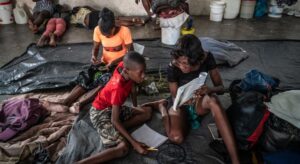
[ad_1]
Kamjong Hill District is home to the Tangkhul tribes, who live in small, self-sufficient communities. State Immunization Officer, Manipur, Dr. Chambo Gonemi said, “There are 19 health sub-centres in Kamjong district. Most of the villages are sparsely populated and connectivity remains a problem, especially from April to November, when landslides block transport on the roads during the rainy season. So, in isolated hill districts, maintaining human resources becomes a challenge, but now infrastructure is improving.”
The four-bed Primary Health Center (PHC) in Phungyar, with two medical officers and five other personnel, works in 38 villages, supported by 29 ASHA workers (community health volunteers).
Tonrefi Jajo, a medical worker at PHC Phungyar, says, “Transportation has improved over the past year because of the new roads. Now it takes me less time to reach communities.”

Dr. Prakash Bhardwaj, Kamjong district medical officer, says, “Many of the communities we serve have to travel several hours by road to reach a health center. Since there is no public transport facility for them, we try to help them through accessibility schemes.”
“ASHA workers oversee the health and immunization program and organize site visits for medical workers in different villages. These medical workers carry equipment, vaccines and medicines to immunize children in villages on designated days and prevent non-communicable diseases. And take action as needed by checking the community for other health problems.”
An ASHA worker named Remember regularly visits every household in Kumran (Nagapram) village with a population of 670. “We use the village’s community hall for community health meetings, so that essential health services near Remember can be made accessible to the villagers,” said Isak Ningshen, head of Qumran.

Role of WHO
WHO WHO’s National Public Health Support Network is providing technical and surveillance support to the Government of Manipur for routine immunization and vaccine-preventable diseases, with a special focus on providing services to the unserved and remote areas.
Dr. Roderico H. Offrin, WHO Representative to India, says,World Health Organization – India’s National Public Health Support Network (NPHSN) provides technical and operational support to national and state governments in a variety of ways to strengthen routine immunization programs, including reaching out to remote areas, to state and This includes developing district-level action plans, advocacy at the national and state levels, and helping strengthen accountability through task forces.
Through this network, through monitoring and capacity building of health workers, evidence generation is also facilitated up to the district sub-division level to remove barriers, drive reforms and ensure the safety of every child, he added. May be.”
Under the Universal Immunization Program of the Government of India, approximately 26.7 million children and 29 million pregnant women are immunized annually against 12 vaccine-preventable diseases, free of charge.

Nationally, vaccines are given to prevent nine diseases – diphtheria, pertussis, tetanus, polio, measles, rubella, severe forms of childhood tuberculosis, hepatitis B, and meningitis and pneumonia caused by Haemophilus influenzae type b.
In some states, vaccination against rotavirus diarrhea and pneumococcal pneumonia is carried out and is currently being expanded to the whole country. At the same time, in endemic districts, children are given vaccine to prevent Japanese encephalitis.

[ad_2]
Source link





